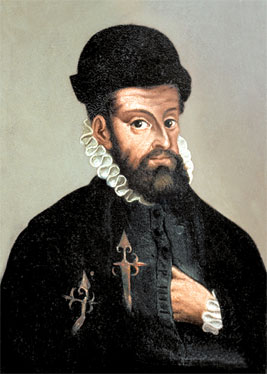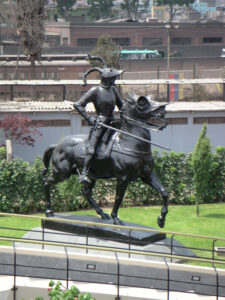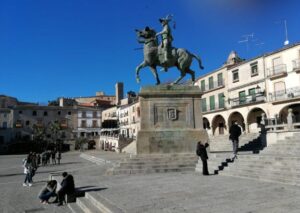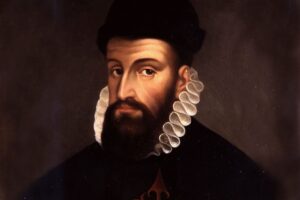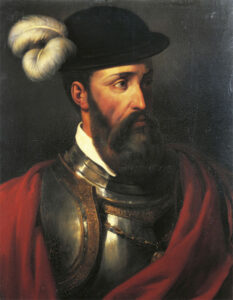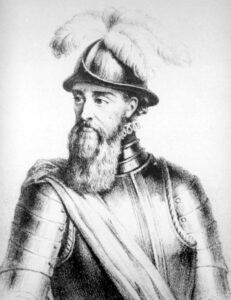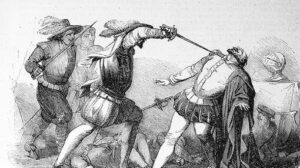Biography of Francisco Pizarro
- Summary
- Family and youth
- Santo Domingo and Tierra Firme
- Conqueest of the Perú
- Diego de Almagro
- Death
- Historical significance
Summary
Francisco Pizarro was a Spanish conquistador, politician and marquis born in Trujillo (Cáceres-Spain) between 1478 and 1483 into a noble family. At a very young age he moved to Seville where he embarked for the Indies in the fleet of the governor Nicolás de Ovando in 1502.
Here he would have a very active role in diverse scenarios of the conquest. He resided in Santo Domingo from where he left in 1509 with Alonso de Ojeda to the conquest and colonization of Tierra Firme. With Vasco Núñez de Balboa he explored present-day Panama and participated in the discovery of the Pacific Ocean, or South Sea as it was then called, in September 1513.
In Panama he was under the orders of Governor Pedrarias Dávila and earned fame and respect, being named Mayor of Panama. News reached this city that sailing south there was a rich and prosperous kingdom. Pizarro did not hesitate and associating with Diego de Almagro and Hernando de Luque organized several expeditions that culminated in 1532 with the conquest and fall of the Inca empire ruled by Atahualpa.
He founded several cities in Peru such as Lima, Trujillo and Cuzco (refoundation). The possession or not of this city, capital of the Inca empire, generated a lawsuit between Francisco and his partner Almagro that ended with a military confrontation between troops pizarristas and almagristas in the battle of the Salinas, in 1538, in which the pizarristas were victorious and Almagro was captured and executed. These events provoked the formation of two sides, the Pizarristas led by Pizarro’s brothers, and the Almagristas by the followers of Almagro’s son, known as the Mozo.
In 1539 Emperor Charles V granted Francisco Pizarro the title of Marquis. He died in 1541, assassinated by the Almagristas, who thus avenged the death of Diego de Almagro.
Biography
Family and youth
His father was a military man named Gonzalo Pizarro Rodríguez de Aguilar, nicknamed El Largo, and his mother was Francisca González, a servant of the Monastery of the Freilas de la Puerta de Coria, in Trujillo. His youth was spent in the family home, probably helping to take care of the family’s livestock business until 1493 when he left for Seville, which was buzzing with news of what was happening on the other side of the ocean.
Santo Domingo and Tierra Firme
In 1502 he embarked on the expedition of Nicolás de Ovando, the new governor of Santo Domingo, and settled in this recently founded Spanish city in the Caribbean. There he spent his first years and later went to Tierra Firme with Alonso de Ojeda, governor of Nueva Andalucía. These were the first steps in the colonization of the American continent. Pizarro was part of the men who founded San Sebastián de Urabá, a fort that would last a few days and where Pizarro took over its direction while the governor traveled to Santo Domingo for supplies and reinforcements, but he would never return. The one who did arrive was Martín Fernández de Enciso, Ojeda’s partner, and with him Vasco Núñez de Balboa, who would take power and with him would begin Pizarro’s rise among the conquistadors.
In an expedition in 1513 with Balboa they discovered the South Sea, which greatly expanded the possibilities of exploration and conquest. And the following year Pedrarias Dávila, the new governor of Castilla del Oro, arrived and Pizarro quickly gained his confidence and gave him land, cattle and Indians. In 1519 Pedrarias ordered the arrest and execution of Vasco Núñez de Balboa for treason against the king and it was Pizarro who executed the arrest order. For this, Davila rewarded him with the position of mayor of the recently founded city of Nuestra Señora de la Asuncion de Panama and gave him encomiendas. These events provided Pizarro with a lot of income and a high standard of living.
Conquest of the Perú
In 1524 news was reaching Panama that sailing southward along the Pacific coast there were great civilizations and riches. It was an investment opportunity and Pizarro, together with his friend Diego de Almagro and the priest Hernando de Luque, who was really nothing more than a front man for the lawyer Gaspar de Espinosa, mayor of Darien and ombudsman of the Royal Audience of Santo Domingo, who may have been the main financier of the project, set out on it.
Between 1524 and 1531 there were three successive expeditions in search of the riches associated with the name of Birú or Peru. On the first trip in the Santiago caravel, together with a hundred men, they only sailed south a few leagues to the Birú River, where they had very violent encounters with the local natives. Diego de Almagro, who arrived a little later to the same area, suffered a wound in one eye that left him one-eyed. This first expedition was a failure and Pedrarias, the governor of Panama, wanted to cancel the whole thing but Pizarro and Almagro insisted and managed to get him to allow them a second expedition in which they would try to reach further south. For this they hired the pilot Bartolomé Ruiz, an experienced navigator in the American waters.
They left on March 26, 1526 in two ships with 160 men. They sailed south, just like the other time, reaching the San Juan River and Gallo Island. The problems of hunger and disease began to spread. Almagro decided to return to Panama to get reinforcements and supplies and while Pizarro remained on Gallo Island where his men asked him to return to Panama.
When Almagró arrived in Panama he found that the new governor, Pedro de los Ríos, had withdrawn his support for the expedition and ordered everyone to return. He sent two ships to pick up the expeditionaries at the end of September 1527 and when they arrived at the island of El Gallo, the famous scene occurred in which Pizarro, when he learned of the governor’s orders, was against obeying them, painted a line on the land and invited those who wished to follow the expedition to join him and those who did not, to stay where they were. Thirteen men supported him; they are the well-known Thirteen of Fame. The captain sent by De los Rios, Juan Tafur, could not oppose and embarked the men and left Pizarro and his followers on the nearby island of Gorgona, where they spent several months until Almagro arrived in 1528 with two caravels and supplies.
They continued sailing south and reached the Santiago River and soon after the first important city: Tumbes, which had walls, fortresses and temples built in stone and a size that confirmed the suspicion that there were rich civilizations. With this good news, they decided to return to Panama and prepare the third expedition, which would be the definitive one.
With the new news of discoveries of new lands, Pizarro went to Spain to meet with the crown and request permission for the new expedition and negotiate the conditions. They were the Capitulations of Toledo of 1529 and in them the main beneficiary was Pizarro to be granted the best conditions and to his two partners Almagro and Luque much smaller benefits, something that would end up causing friction and quarrels between the two conquerors.
Once he returned from Spain, he set out quickly: at the beginning of 1531 he left Panama with 180 men. This time being an expedition of conquest and not of exploration, they sailed to the bay of San Mateo and from there they continued on foot, visiting the towns along the way and making contact with the natives. They arrived at Tumbes and found it destroyed by the civil war that was taking place between Atahualpa and Huascar for the control of the Tahuantinsuyo. They founded the city of San Miguel de Piura and they continued their way until arriving to Cajamarca where they had news that the Inca chief was in the surroundings.
After the first contacts they arranged to meet in the central square of Cajamarca and there the encounter took place that ended with a confrontation between the Spanish troops and the Incas with the defeat of these and the capture of Atahualpa, who was prisoner of the Spaniards until his trial and death the following year. Before this Atahualpa had promised to fill a room with gold and silver in exchange for his freedom but as time went by the threat of an Inca attack became greater among the Spaniards and they decided to put him on trial and get rid of him. And so it was on July 26, 1533 when he was executed by garrotte vile.
In order not to leave a political vacuum in the Inca empire, although it was already under Spanish sovereignty, Túpac Hualpa, Atahualpa’s brother, was named as Inca. But it did not last long, on the way to Cuzco he died. They settled in Jauja, a recently founded city, from where they managed everything. Later they marched to Pachacamac from where they decided to explore the valley of the Rimac River to found what would be the capital of the viceroyalty: Lima, which at first was called City of the Kings.
Diego de Almagro
From here he will send Diego de Almagro to the conquest of Nueva Toledo or Chile, territory that the king had assigned to Almagro 200 leagues from the south of Nueva Castilla. In those days his brother Hernando arrived and he sent him as lieutenant governor in Cuzco.
In May of 1536 Manco Inca, who had been named Inca in substitution of Túpac Hualpa, revolted in Cuzco where he took as prisoners the brothers Hernando, Juan and Gonzalo Pizarro. The Incas under the command of Tito Yupanqui also attacked Lima in the month of August managing to besiege it but not to take it. To the few weeks reinforcements arrived to the command of Alonso de Alvarado that managed to kill Tito Yupanqui and to put in flight the Inca troops toward Cuzco. Lima had been saved. Alvarado, taking advantage of the inertia, marched to Cuzco where Almagro had expelled Manco Inca, who fled to Vilcabamba.
Almagro went down to the coast to found Chincha, a city that Pizarro claimed as his own because it was within his jurisdiction. Finally to solve all these frictions they met in Mala on November 13, 1537 trying to reconcile, for it Almagro set free the Pizarro brothers in Cuzco. But Pizarro no longer trusted Almagro and sent his brother Hernando to the head of an army with the objective of recovering Cuzco and to finish with Almagro’s men. Both armies met on April 26, 1538 in the field of Las Salinas, near Cuzco, where Pizarro defeated the Almagro’s men and their leader, Diego de Almagro, was condemned to death and executed on July 8, 1538.
Death of Francisco Pizarro
.
After these warlike years peace came to New Castile, although the Almagro supporters led by Diego de Almagro el Mozo maintained their protests and claims. In 1539 Pizarro founded San Juan de la Frontera de Huamanga and received a royal decree from Emperor Charles V in which he was granted the noble title of Marquis but without assigning a name to it because it was not well known which lands he had conquered or not.
In these years Pizarro had a quiet life carrying out administrative tasks in Lima until June 26, 1541, when a group of almagristas broke into his house and assassinated him.
Historical significance
Francisco Pizarro, like others, is the typical figure of the Spanish conquistador of the 16th century: a nobleman without great resources, adventurous, enterprising, a good companion, cruel if he had to be, soft at times. Starting almost from scratch, he marched to the newly discovered New World and gradually rose through the ranks until he conquered the second great empire of America: the Inca. He tried to create a new mestizo society by mixing with the natives at all levels and ended up assassinated by his political rivals.
Videos
I add a couple of biographical videos of Francisco Pizarro:
Related images
Works
Verdadera Relación de la Conquista del Perú, Francisco de XerezLa vida de Francisco Pizarro por Manuel José Quintana
Para referenciar este artículo:
Martos, David. (03-08-2023). Biography of Francisco Pizarro. Blog Historia del Nuevo Mundo. https://www.historiadelnuevomundo.com/en/biography-of-francisco-pizarro/
